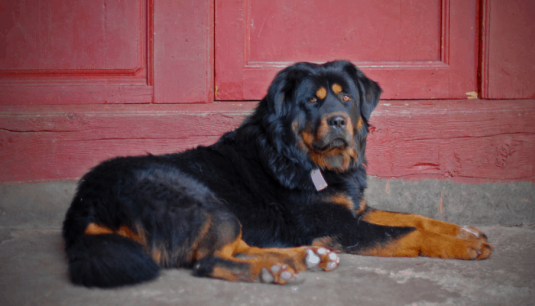
India has twenty-eight states, each with its own favorite local drink. By far, however, tea is common to all of them, and Masala Chai is the most famous and popular flavored beverage in the whole of the country. It is simply black tea with a mixture of aromatic Indian spices and herbs. Interestingly, Masala tea wasn’t one of the top queries in Google’s “how to” section for Indians during 2020. That was Dalgona coffee, a Korean-born beverage made by whipping equal proportions of instant coffee, sugar, and hot water until it become creamy and then is added to hot or cold milk. Yum!
What has this to do with purebred dogs? Not much beyond introducing a breed from India, the Bakharwal, known in English as the Kashmiri Mastiff. One of the oldest breeds in the India, the Bakharwal is indigenous to the higher altitudes of the Pir Panjal mountain area of the Hindu Kush and the Himalayas. There, it was bred for centuries by the Bakarwal and Gujjar nomadic tribes as a livestock guardian dog and to protect settlements. The word Bakharawal, in fact, comes from bakri which means goat, a nod to their original task as an LGD.
There are two lines of this breed, the “simple Bakharwal,” and the “Ladakhi Bakharwal.” We find particularly fascinating an aspect of the Ladakhi Bakharwal, and that is a unique ability to “open mouth bark;” This is non-stop barking without taking a breath, or continuous barking in one breath for an extensive period of time. As ferocious a protector as the Bakharwal is, we suspect (with tongue planted firmly in cheek) that non-stop barking alone is enough to drive a wolf deep into the mountains.
But maybe not. Legend has it that the breed was developed during the primitive times by crossing wolves with a breed of Molosser sheepdogs over 300 years ago.
Another legend more rooted in history is that the British used the dogs to pull large carts across the Himalayan region because of their sheer strength.
As if all that isn’t interesting enough, we also came across several sources that describe the Bakharwal as a vegetarian. Dogs are said to prefer milk and bread to any other type of food, and certainly over flesh. Is diet a genetic preference? We know that nomadic tribes raised their Bakharwals on Phulkas (wheat flatbread), milk, and paneer (cheese), and many Indians believe this diet preference has been inherited in the dogs’ genes.
If you detect a similarity to the Tibetan Mastiff, there are those who believe the TM is indeed part of the Bakharwal’s ancestry. Typical of most mountain dogs, the Bakharwal is a heavily coated, heavy boned, good sized dog that is powerful, agile, and sturdy statured. Those qualities once attracted the Indian Police Service to use these dogs to find militants across the country, “just deserts” since one of the major reasons the breed is rare even in its country of origin is that they were shot on sight by separatist militants near the Jammu and Kashmir border.
In 2009, the Tribal Research and Cultural Foundation conducted a survey on the breed which found that only a few hundred of these dogs remain. It resulted in an appeal being made to the Ministry of Environment to protect them. It is hoped that this unique breed can be saved from vanishing, and things are looking up because of locals of the Himachal region who are helping revive the breed.
Image found on Pinterest and happily credited upon receipt of information
